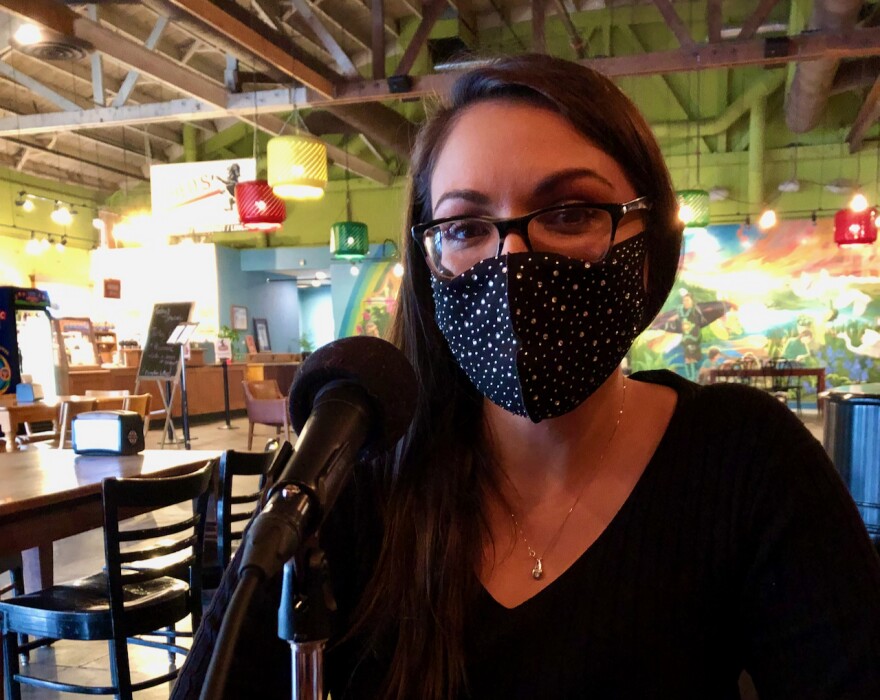“Now Hiring” is a sign of the times in Oregon, as many economic sectors face a worker shortage. One employment model gets people into jobs right away with little to no debt, and a chance at stable, lifelong employment. Apprenticeship is the topic for the second story in our series, “Workin’ It.”
Joe Napier is an apprentice in an electrician program at Linn Benton Community College. He told KLCC, “This whole journey through school and the apprenticeship has just been absolutely life changing for me and my family. It’s the best thing I think I’ve ever done.”

Napier takes classes at night and works with a journeyman mentor at Hewlett Packard, troubleshooting, all day.
“Having that diversity of challenges is awesome," he said. "You spend all day scratching your head and trying to figure it out, and at the end of the day you finally discover what the actual issue was. It’s really rewarding and satisfying to be able to go home knowing that you figured it out.”
Apprenticeship as a form of education goes back thousands of years. Abby Bandurraga with the Oregon Bureau of Labor and Industries, or BOLI, explained, “A town needed a blacksmith and so they would send generally a male, generally a young person, to the next town that had a blacksmith and they would receive training from that blacksmith and upscale until they became equal, equal level of skills.”
Bandurraga said it hasn’t changed much. But in Oregon, under BOLI Commissioner Val Hoyle, things are evolving.

Ashley Espinoza is with Lane Workforce Partnership and sits on the BOLI council that approves new apprenticeship programs. She said, “The commissioner is such an advocate for expanding apprenticeship opportunities beyond the trades, and looking at bringing in more people of color and women into the trades. I mean that is right on the website for her.” The state recently added tracks in behavioral health and a nationwide pilot for firefighters.
The pandemic, Bandurraga said, has added some urgency. “You can wait for a group of folks to go and do everything in a purely academic setting," she said, "or you can start working with individuals, utilizing their talents while they’re getting on the job training and building those skills, and they’re getting paid, and so it’s kind of win win for everybody.”
Companies have to commit to sponsor apprentices, but the current labor market has created interest in areas from child care to cannabis.

In a Springfield City Club presentation, Commissioner Hoyle said to attract students, people need to stop stigmatizing apprenticeship programs. She said electrical lineman can make six figures, and the job takes smarts, adding, “You do want the best and brightest putting in your electrical work, right, because if they do it wrong, people die.”
Bandurraga said trades also have to move away from the traditional recruiting strategy. “Sometimes we refer to it as, they were passed down by the FBI, or the father, the brothers and in-laws," she said. "And so if you weren’t a part of the demographics that made up the construction trades at that time, you weren’t really getting those invitations.”
Mary Ann Naylor is with Oregon Tradeswomen, a nonprofit advocacy group. She said women weren’t allowed into apprenticeships until the passage of Title IX in 1972 and that, “It’s either 1976 or 1978 that there was a goal put forward of 3%, to get women’s involvement in the construction trades at 3%. We’ve hovered at that number as an industry, nationally, since that time.”
Naylor said Oregon outpaces most of the country with 9% women in construction, but women and people of color don’t finish apprentice programs at the same rate as white males. Solutions include peer-to-peer groups and pre-apprenticeship programs, which show people what the options are, and what’s required.

She noted, “Our pre-apprenticeship program includes construction math, it includes guest speakers, it also includes fitness training. It includes money management, financial competency, I think, is the term that people are using now.”
Oregon Tradeswomen runs a program for employers as well. It’s called “Rise Up,” and it aims to stop the traditional hazing that Naylor said doesn’t play well today. Espinoza agreed that’s key. “This whole process really starts and ends with the employer," she said. "And I think that to be able retain and to attract people that have not historically been participating in this system, I think we’re really going to have to look at worksite culture.”
BOLI also has employer training, and it’s hired a Diversity, Equity and Inclusion position, and a dedicated case manager for veterans.

Malynda Goodman is an apprentice at Cascade Steel Mill in McMinnville, where she worked for over 20 years before starting the program. She takes classes at Linn Benton and said, “When I first came in, you know, I’m older, there’s not many women millwrights, and then coming back to school was absolutely terrifying. Now it’s like a family, it’s something I look forward to. It’s just changed everything.”
Goodman and others emphasized it’s rigorous. Most paths are four years of classwork and 8,000 hours of apprenticeship. But she wants people to know, it’s attainable. “You can do it, if you put your mind to it," she said. "It does not matter about age, it does not matter about gender, it does not matter about size, that you don’t have to be perfect at anything, if you’ve got a curiosity, find your niche.”
Oregon has 10,400 apprentices sponsored by 5,000 employers. Keep an eye on those numbers, as the model is poised for growth.
Funding for KLCC's "Workin' It" series comes from the University of Oregon's Wayne Morse Center for Law and Politics.



